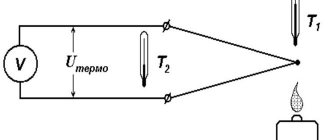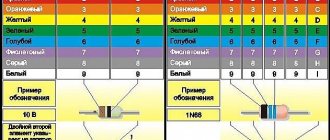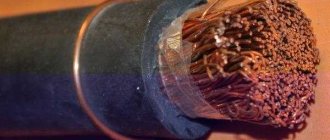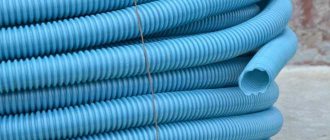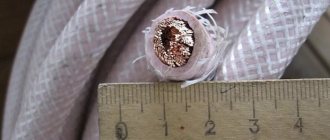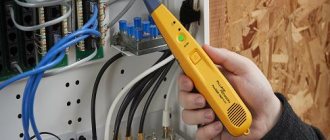The modern cable industry has a huge assortment of all kinds of wires. Each of them solves a specific problem. Any electrical installation is carried out with aluminum, and more often copper wires and cables. The cores of these cables can have a solid or separate structure - when they are filled with many wires. The flexibility of the cable depends on the structure, but not the conductivity value. But the features of the cables don’t end there. After all, their range is amazing. PVS, ShVVP, VVG - what are the advantages? The answer is simple: in the properties of insulation.
The article will tell you about the basic types of electrical wiring and methods of their operation.
VVG cable
With the help of this conductor, residential buildings are electrified. Its markings show: flexibility of cores, insulation on the outside - polyvinyl chloride, insulation of rods - similarly. The wiring is not particularly flexible.
The cable insulation is resistant to environmental aggression, and the cable itself does not burn. The cores consist of one or many wires, taking into account cable modifications.
This cable must deliver and distribute electrical impulses at a factor of 1000 volts when the AC power frequency is 50 Hz. For equipping home networks, a VVG liner with a cut of 6 square millimeters is suitable; for supplying light to households, this norm increases to 16 sq. mm. A break along the shortest radius is possible with a cord 10 times wide. The cable is supplied in coils of 1 hundred meters.
The VVG cable has a gradation: AVVG - aluminum core, VVGng - fire-resistant sheath, VVGp - flat cut, VVGz - the presence of PVC or rubber insulation between the cores.
VVG – copper cable – for indoor installation. It is laid openly, laid in grooves. Serves for 30 years. The number of cores meets the requirements of the network phases: from 2 to 5. The predominant tone of the surface insulating material of these leads is black, sometimes white. Modifications of the VVG cable with “NG” and “LS” show, respectively, non-propagation of combustion and low smoke emission during fire. A modification of the VVG is known that can withstand open fire for several minutes.
The foreign analogue of the VVG cable is produced according to the DIN standard. We are talking about the NYM product. Its special internal filler extinguishes itself.
Choose a GOST or TU cable?
In a separate article, we looked at the differences between GOST and TU cables. In short, any cable is manufactured according to the technical specifications of the plant (abbreviated as TU). This means that the manufacturer declares certain conditions that the cable meets (resistance per 1 km of cable, sheath and insulation materials, filler, type of metal, etc.). At the same time, each plant has the opportunity to obtain compliance of its plant’s specifications with the state standard (abbreviated GOST).
If a plant receives GOST for its products, this means that the cable production plant’s specifications comply with the GOST standard. In common people, the cable that does not pass certification is called TU (because the cable complies with the Technical Conditions of the plant, but does not comply with GOST), and the cable that has passed certification is called GOST (that is, the plant’s specifications comply with GOST).
Very often we are asked the question - what to take, GOST or TU? This decision remains primarily yours. We, for our part, believe that the optimal cable in terms of quality-price ratio is the VVGng GOST cable - that is, a flat cable without filler, but made in accordance with GOST. It is more than enough for household needs.
NYM cable
Copper solid-wire conductors with current, with PVC insulation and a protective sheath, do not burn, are not afraid of aggressive environments. The first 5 cores are available with a cut: 1.5 - 35 square units. – in the body of a white protective sphere. The conductors are adjacent to dense coated rubber: there are no halogens, the cord is durable and heat-resistant. Its functionality is from -40°C to +70°C and is moisture resistant. Colored insulation: light green, bluish, brown.
The NYM cable serves lighting systems in technical and civil construction - voltage limit is 660 units. The product is laid indoors and outdoors, hiding it from the sun in a corrugation. Installation allows bending of the radius - at least 4 diameters. It goes in bays starting from 50 meters. When compared with VVG, this liner has only copper and solid wire cores. It is convenient to lay it.
GOST and rules when choosing a cable
These rules are uniform and are currently valid not only for special buildings and facilities, but also for offices, apartments and other residential premises. Although, of course, all GOSTs and sets of rules change sooner or later.
For example, few electricians imagined that aluminum wiring would legally return to our homes. But nevertheless, it happened.
However, when it comes to choosing a cable for home wiring, we will stick to the current GOSTs for now and see what they are talking about.
At the moment, the main regulatory document regulating the use of certain cable products, taking into account the type of their use, is GOST 31565-2012 “Cable products. Fire safety requirements."
In this GOST you can find a decoding of all the letter designations that are present in the name of the cable and relate specifically to fire safety:
ng
L.S.
FRLS
LTx, etc.
It is also very clearly described here which type of cable should be used in a particular area. This information is contained in table No. 2.
In the first column, where it says “Cable without markings,” we mean the usual VVG. It can only be used in industrial premises and cable structures.
There is no talk of residential buildings or apartments here. Moreover, if you want to lay it in bunches, you will have to protect it with pipes and corrugation (passive fire protection).
The second column refers to the cable with the index NG (VVGng). There are additional letters in brackets (A) (B) (C) (D). As a rule, VVGng (A) cable is used.
The letter in brackets indicates that the cable meets flame retardant requirements. Simply put, if there is such a letter in the name, then the cable can be used for group installation.
But here too the area of application is cable structures for outdoor installations. As you can see, again there are no offices, apartments or residential buildings.
The third line is exactly the VVGng LS cable.
And as can be seen from the column opposite, it can already be safely installed in the interior of residential buildings.
SIP cable
The code is interpreted as a “self-supporting insulated wire.” He is not afraid of collisions with mechanics. Its insulation is cross-linked polyethylene; it is often used as an outdoor cable for power lines and individual branches. Replaces bare A and AC cords.
starts from 25 rub./m.
This is an aluminum cable with no overall insulation. The core cross-section is 16 units, the largest is 150 units. The marking does not indicate the number of cores - there is a nomenclature number.
SIP-1 is a liner made of 2 cores, one is a zero carrier. Options 2 to 4 – cores with a single zero carrier. Sample-4 consists of 4 current-carrying rods.
Installation of SIP requires specific tools: brackets - anchors with connection and branch clamps.
What does GOST say about this?
Is it possible to wire a house using PVS wire? After all, working with him is much more comfortable and even easier?
Each type of wiring has its own purpose. For example, the rules for electrical installations state that wires and cables must be used only in accordance with standards and technical specifications. And if you open GOST 7399-97, you will see that the PVS wiring, according to its intended purpose, is only suitable for connecting electrical appliances and using extension cords.
PHOTO: masterpotoku.ru Thus, the PVA can only act as a movable electrical wiring. You can use it to connect a TV, a vacuum cleaner, a refrigerator, or make a carrying case out of it.
In this role, PVA has no equal, because stranded wire is very durable and is not afraid of kinks.
It turns out that GOST does not imply the use of PVS as stationary wiring. And, in addition, according to the same GOST standards, the service life of PVS is only 6–15 years, and that of VVG is at least 30 years. So think about it, do you want to change the wiring every 10 years?
Expert opinion
It-Technology, Electrical power and electronics specialist
Ask questions to the “Specialist for modernization of energy generation systems”
What cable should I use for wiring in my apartment? In this article I will present only TWO types of cables that 99 electricians currently use in their work in the fall of 2022. Ask, I'm in touch!
Cable – PVS cord
PVA - made of copper with a vinyl insulating base. It fits into the void between the rods, so the wire is strong. Cores 2 or 5, cut - from 0.75 to 16 square millimeters. The temperature norm is -25°C – +40°C, it is not afraid of moisture and chemical attacks. The wire is bent repeatedly. The shell is white. Veins of all shades.
PVS wire – power cord for household appliances and extension cords. Flexibility is an important advantage of the product.
Insulation – polyvinyl chloride. The internal insulation of the cores is with standard markings. PVA cores are multi-wire. They are terminated or tinned. The cable is ideal for powering portable electrical receivers.
PVA copes with mechanical loads. The cross-section of the cores varies from 0.75 to 16 square meters. mm.. It is used in the production of extension cords and carriers when used in warm conditions. The shell cannot withstand frost.
KG cable
KG is a flexible rubber cable made of copper with stranded conductors, their cross-section is 0.5 to 240 sq. mm. Quantity – 1-5. Natural rubber – for rubber insulation of conductors.
The cable is functional from -60°C to +50°C, humidity – 98%. The cable is laid outdoors. Core color: black, blue, brown, gray. The scope of application of the CG is industrial installations. The KG cable powers portable mobile devices from alternating current or from generators. During installation, bending along a radius of at least 8 outer diameters is possible. A modification of KGng is provided - non-combustible insulation. The rubber insulation of this cable retains its properties and flexibility in frosty conditions. Extension cords based on it are used in any conditions.
The best cable for wiring in an apartment. NYM and VVGng-LS - differences, characteristics.
Today there is a huge selection of cable products, and not even all electricians can thoroughly understand their designations and names without special literature. The first question that arises before a consumer who decides to repair the electrical wiring at home is which cable should I choose?
Let's consider only those types of cable that most often need to be used when installing and replacing electrical wiring inside an apartment or house. Finding them in construction stores is not difficult.
However, when purchasing, you must know exactly what their letters in the abbreviation mean, when you need to use one or another brand, and whether it is possible to replace one cable with another if one of the types is not on sale.
The first most common and most correct cable option is VVGng and its variety VVGng-LS. The cable has the following design:
It can be single-core or multi-core. In this case, the conductor was single-wire up to a cross-section of 25mm2. Most often it has a flat shape, which is very convenient when placing it in a narrow groove in a vertical position.
And in plastic cable channels it is convenient to lay wires of this particular shape. At the same time, do not forget that there should still be 40% free space in the cable channel after installation.
First of all, let's decipher all the letters in the abbreviation. Many people often wonder what they mean? means that the insulation is made of polyvinyl chloride material the cable sheath is also made of polyvinyl chloride insulation the cable is bare, without any protective armored cover. Just to remember, electricians call it among themselves:
Some brands after VVG have additional letters in their names:
stands for “flat” means that the cable is not flammable, although it would be more correct to say “non-flammable” cable is not flammable even when laid in bundles
Non-flammable due to the use of special insulation that does not support combustion, both the main core and the outer sheath. During a short circuit, such insulation envelops the wires and prevents them from burning.
Many people mistakenly talk about adding a chalk mixture to the insulation of the cores of a given cable, supposedly to reduce flammability. There's no chalk there.
Only dye is added to the insulation itself, otherwise you won’t get a quality product.
The only purpose for which a chalk-filled mixture can be used is exclusively to separate the insulation from the shell.
To do this, the veins are pre-rolled in a chalk bath during the production process. In addition, this technology helps prevent the cores from sticking together inside the shell.
Remember that the property of not burning a cable is only part of the task. It is necessary that the fire dies out and dangerous combustion products do not spread, and for this it is necessary to displace oxygen from this very zone. The PVC casing of VVGng-LS contains chlorine and other additives that perform this function.
It is because of this that the VVGng-LS brand is primarily recommended for installing wiring inside a house, office, or apartment. this is an abbreviation for Low Smoke, that is, low smoke and gas emissions
All technical data of the most used cable sections VVGng-LS, such as rated current, weight, resistance are presented in the tables below:
One important tip - even if you don’t yet have a grounding wire in your house and the system is TN-C and not TN-CS, still always buy only a three-core cable.
This way you won't have to redo all the wiring if you change your grounding system. Well, as a last resort, the third core will always remain a backup if a break occurs on the phase or neutral wire.
People often wonder, is it possible to use a simple VVGng, without the LS index? The rules, which have changed significantly in recent years, say that for installation inside residential premises, simple VVGng is prohibited.
This brand can only be used outside the building. See GOST 31565-2012 – download.
This is explained by the fact that although it does not burn, under the influence of a flame it releases a huge amount of toxic substances. But it is because of combustion products, and not from fire, that most people die in fires.
The next brand suitable for indoor wiring is NYM cable. This designation is international and came to us from Germany.
The letter N (Normenleitung) means compliance with the German VDE standard - the union of German electricians. Y (Isolierung der Adem aus Polyvinylchlorid) – core insulation material is polyvinyl chloride, just like VVG.
M (Mantelleitung) – installation cable with a protective sheath for installation inside buildings and structures
domikelectrica.ru
Cable VBBShv
Power cable with copper current-carrying conductors: single-wire and multi-wire, protected by armor. The first 6 cores have a cross-section of 1.5 - 240 square millimeters. There is a PVC coating and an insulating base. The cable is distinguished by the presence of a layer of steel double-tape armor between the sheath and the rods. The cable is designed for -50°C to +50°C, humidity up to 98%. PVC insulation guarantees resistance to aggressive environments. Black shell. The insulation is either black and white or plain.
VBBShv armor is used to lay power supply networks for autonomous structures and buildings, in pipes underground and above. Maximum AC voltage is 6000 volts. Direct current requires single-core cable modifications.
The radius bends are the same. Usually supplied from 100 meters in coils. Modifications: AVBBShv - aluminum conductors, VBBShvng - non-flammable version, VBBShvng-LS - non-flammable mode with low gas emission at high temperatures.
from the manufacturer “Elektrokomplekt” will pleasantly surprise you. In addition, the company is represented in 8 cities of Kazakhstan.
Wire PBPP – PUNP
Copper flat wire: single-wire cores, 2 or 3 pieces, PVC insulation and sheath. It works normally if the atmosphere is -15°C to +50°C, humidity limit is 98%. Tolerates aggressive environments well. Black or white, blue or greenish veins.
They are good at installing lighting systems and wiring sockets in buildings, with a maximum of alternating current with an industrial frequency of 250 volts. The radius bends at a level not inferior to ten times the width. Delivery mode - coils of 100 and 200 meters. The modification of PBPPg (PUGNP) is of a multi-wire type, the bending radius is not less than 10 times the width. APUNP has solid wire, only the cores are made of aluminum.
Analogs of cord with polyvinyl chloride insulation
Despite the versatility of the connecting wire, there are no less popular analogues that have identical properties and characteristics, appearance and installation requirements. Such wires are also made in accordance with GOST and are divided into three main groups .
- High temperature cables.
- Flexible cables.
- Flat cables.
Analogs of high-temperature cable include PVSng-LS; it is actively used in wiring with increased fire safety requirements. Its marking indicates low flammability properties and low smoke formation during a fire. This cable consists of five cores and the outer sheath is also made of PVC and is white in color.
The cable can operate at a minimum temperature of -40C, and a maximum of +40C, with a maximum operating temperature of +70C.
An analogue of a flexible cable, a cable marked KG, is highly resistant to high humidity and open air, although the service life does not always reach five years. This wire is resistant to repeated unwinding and winding; the rubber insulation casing is highly resistant to low temperatures, but not lower than 60C. The wire is actively used in welding work and on river vessels. There are from one to five cores in the wire structure.
In lighting networks, analogs of the flexible cable PUGNP or PBPPG, APUNP, PGVVP are often used. Decoding PUGNP indicates that the wire is flexible, flat and universal. Its outer shell is not suitable for outdoor use, so it is widely used in household electrical wiring. The service life of this wire is 15 years.
Product PPV
A flat cable with copper rods and a single rod of PVC insulation with inserts - separators between the cores. Their number: 2 or 3. The wire is approved for operation in conditions: -50°C to +70°C.
It is not afraid of vibration, does not burn and loves 100% moisture. Snow-white shade.
PPV material is indicated for stationary lighting and internal networks for domestic use. Voltage 450 volts with alternating current frequency up to 400 Hz. The radius cannot be bent less than 10 times the width. Deliveries - 100 meters through the bays. A variation of APPV - aluminum conductors.
Wire PV1
Round cross-section type, PVC insulation, copper, 1 core. The temperature, like other cables, is from -50°C to +70°C, withstands vibration and chemical irritation, humidity - up to 100%. Insulation is offered in different colors.
Scope: transformers, switchboards, electrical equipment. The wire is rated for voltages up to 750 volts with alternating current with a frequency of up to 400 Hz, and up to 1000 volts with direct current. It is laid underground and outside, in cable trenches. The material is defenseless against sunlight. The bending value is at least 10 times the diameter of the wire. Bays from 100 meters. The AR wire is a modification of PV1, but the core is made of aluminum.
Let's sum it up
What has been said can be summarized as follows. Each of the materials considered has specific application features. When choosing conductors for specific purposes, you should carefully understand the difference between VVG and PVS. In conclusion, I would like to list a couple more aspects that may influence the choice.
The first aspect is price. It is possible that a lower price will determine the choice in favor of one material or another. In this case, it is necessary to accurately weigh all the disadvantages that are acquired with a gain in price.
The second aspect is design features. The cable can be flat, which in some cases creates additional convenience during installation. The wire, in turn, being softer, fits more conveniently into cable channels.
Finally, we recommend watching the video, which presents the opinion of experts:
We hope the information provided helped you understand what is better to choose for electrical wiring: PVS or VVG and what is the difference between the two brands of conductor products under consideration!
Wire PV3
Single-core copper wire of oval cross-section in PVC insulation. The stranded wire core can have a cross-section from 0.5 to 400 sq. mm. The operating properties are repeatable.
They are used for the purpose of electrification: when installing distribution boards, lighting in work shops, where frequent bending is appropriate. The wire is powered from 750 volts at 400 Hz alternating current, and up to 1000 volts at constant current.
The application is similar: you can add auto tuning and home risers. Sun protection is indicated.


